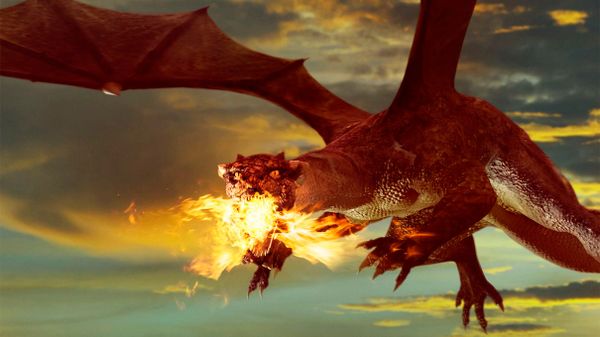
Key Takeaways
- Fire-breathing dragons and creatures with torch-like teeth are not likely to exist from a scientific standpoint.
- Such creatures would need specialized organs and biological processes to produce and control fire.
- The existence of dragons is implausible, based on current scientific understanding of biology and physics.
Fire-breathing dragons really capture the imagination — leading many writers to ponder just how such a creature might spew forth a torrent of flame. How do we square such a fantastic adaptation with real-life biology?
Most theorists dismiss the notion that dragons actually exhale fire through their throat and lungs. We can't place a furnace inside a living creature without breaking all the rules of biology. Instead, they tend to explain the monsters as a sort of flame thrower. The creature merely spews forth a flammable liquid or gas, which it ignites with a toothsome spark.
Advertisement
For example, Robert A. Heinlein unleashed just such an explanation in his 1963 novel "Glory Road:"
Heinlein imagined a chemical reaction to ignite the dragon's fire, while biologist Frank van Breukelen proposed the physical spark of flintlike scales. But in either case, how would fire breathing affect a dragon's dental health?
While we'd assume dragon teeth to be somewhat fire-resistant, there are limits to how much heat everything can withstand. Hyperthermophiles, such as archaea microorganisms, can take hydrothermal vent temperatures of up to 230 degrees Fahrenheit (110 degrees Celsius). But dragon fire is a whole different type of heat. Wood burns at about around 500 degrees Fahrenheit (260 degrees Celsius) and methane has an adiabatic flame temperature of 3,540 degrees Fahrenheit (1,949 degrees Celsius).
That's some serious heat. So how would the teeth hold up?
Forensic dentists sometimes consider the effects of fire on human teeth. How else might investigators make sense of dental remains after a fire? As pointed out in a 2002 paper in The Journal of Forensic Odonto-Stomatology, human teeth exposed to fire will crack and fragment at between 392 and 752 degrees Fahrenheit (200 and 400 degrees Celsius). By 2,012 degrees Fahrenheit (1,100 degrees Celsius), the roots shatter and the crown is "reduced almost to dust." So even assuming dragon teeth are made of hardier stuff, it's difficult to imagine teeth that could withstand streams of blazing methane.
And yet, here's the catch: For most vertebrates, one set of adult teeth doesn't have to last a lifetime. We're diphyodonts, meaning we only have two successive sets of teeth. Other creatures, like sharks, are polyphyodonts. They continually shed and regrow teeth. While elephants, manatees and kangaroos are the only mammalian polyphyodonts, the approach is widespread among fish, reptiles and amphibians.
So perhaps we're better off considering dragons as polyphyodonts, whose teeth continually fracture and flake under the power of their flames. Then, as the old teeth fall away, new ones pop into place to rip apart the still-sizzling meat of their latest kill.
Plus, isn't a blast from Smaug all the more terrifying if it's full of fragmented dragon teeth? Better take cover, dwarves...
Advertisement


